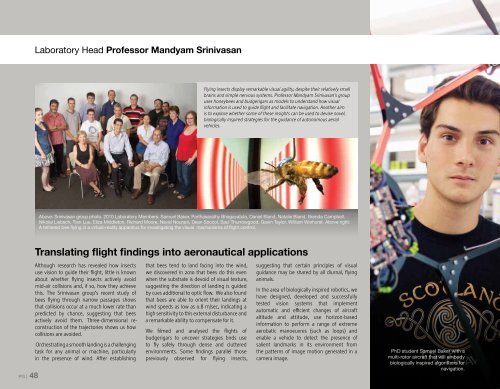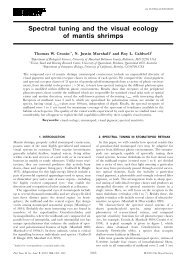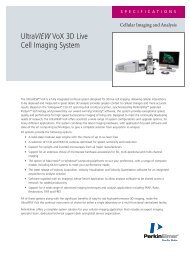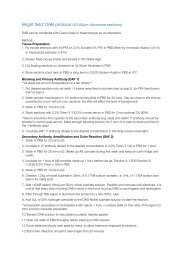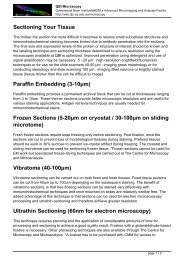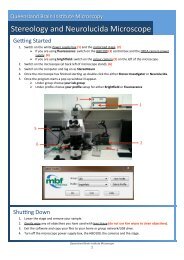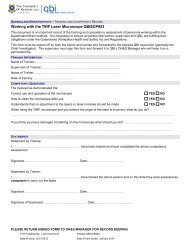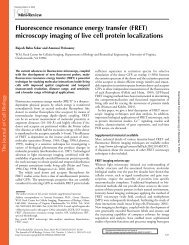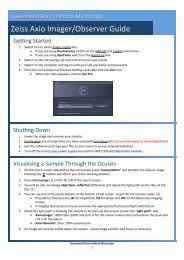Queensland Brain Institute 2010 Annual Report - University of ...
Queensland Brain Institute 2010 Annual Report - University of ...
Queensland Brain Institute 2010 Annual Report - University of ...
You also want an ePaper? Increase the reach of your titles
YUMPU automatically turns print PDFs into web optimized ePapers that Google loves.
Laboratory Head Pr<strong>of</strong>essor Mandyam SrinivasanFlying insects display remarkable visual agility, despite their relatively smallbrains and simple nervous systems. Pr<strong>of</strong>essor Mandyam Srinivasan’s groupuses honeybees and budgerigars as models to understand how visualinformation is used to guide flight and facilitate navigation. Another aimis to explore whether some <strong>of</strong> these insights can be used to devise novel,biologically inspired strategies for the guidance <strong>of</strong> autonomous aerialvehicles.Above: Srinivasan group photo. <strong>2010</strong> Laboratory Members: Samuel Baker, Parthasarathy Bhagavatula, Daniel Bland, Natalie Bland, Brenda Campbell,Nikolai Liebsch, Tien Luu, Eliza Middleton, Richard Moore, Navid Nourani, Dean Soccol, Saul Thurrowgood, Gavin Taylor, William Warhurst. Above right:A tethered bee flying in a virtual-reality apparatus for investigating the visual mechanisms <strong>of</strong> flight control.PG | 48Translating flight findings into aeronautical applicationsAlthough research has revealed how insectsuse vision to guide their flight, little is knownabout whether flying insects actively avoidmid-air collisions and, if so, how they achievethis. The Srinivasan group’s recent study <strong>of</strong>bees flying through narrow passages showsthat collisions occur at a much lower rate thanpredicted by chance, suggesting that beesactively avoid them. Three-dimensional reconstruction<strong>of</strong> the trajectories shows us howcollisions are avoided.Orchestrating a smooth landing is a challengingtask for any animal or machine, particularlyin the presence <strong>of</strong> wind. After establishingthat bees tend to land facing into the wind,we discovered in <strong>2010</strong> that bees do this evenwhen the substrate is devoid <strong>of</strong> visual texture,suggesting the direction <strong>of</strong> landing is guidedby cues additional to optic flow. We also foundthat bees are able to orient their landings atwind speeds as low as 0.8 m/sec, indicating ahigh sensitivity to this external disturbance anda remarkable ability to compensate for it.We filmed and analysed the flights <strong>of</strong>budgerigars to uncover strategies birds useto fly safely through dense and clutteredenvironments. Some findings parallel thosepreviously observed for flying insects,suggesting that certain principles <strong>of</strong> visualguidance may be shared by all diurnal, flyinganimals.In the area <strong>of</strong> biologically inspired robotics, wehave designed, developed and successfullytested vision systems that implementautomatic and efficient changes <strong>of</strong> aircraftaltitude and attitude, use horizon-basedinformation to perform a range <strong>of</strong> extremeaerobatic manoeuvres (such as loops) andenable a vehicle to detect the presence <strong>of</strong>salient landmarks in its environment fromthe patterns <strong>of</strong> image motion generated in acamera image.PhD student Samuel Baker with amulti-rotor aircraft that will embodybiologically inspired algorithms fornavigation.


